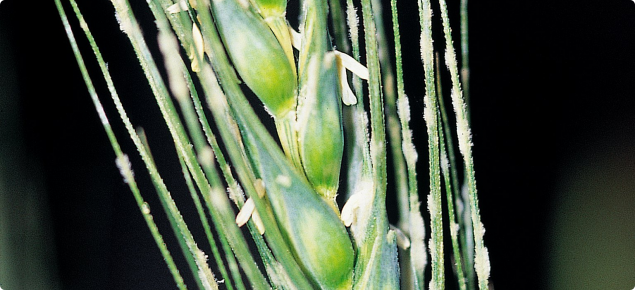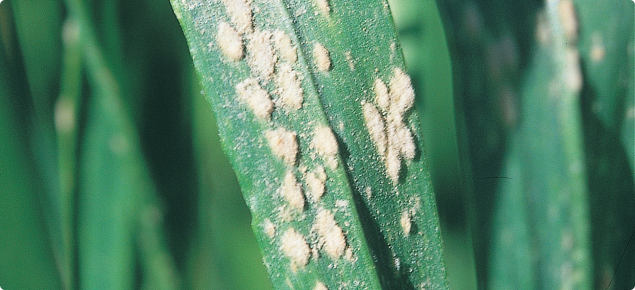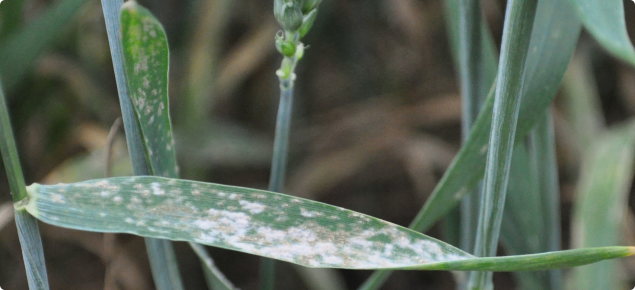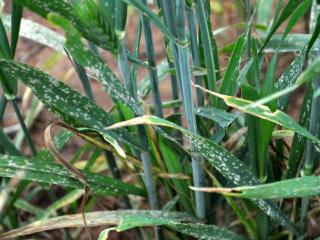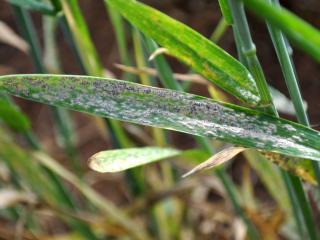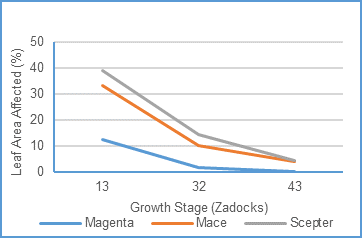Wheat powdery mildew (WPM) infection and development is favoured by high humidity (85-100%) and temperatures of 15-22°C, but tends to diminish in spring as temperatures rise above 25°C and as humidity declines. Disease may persist longer in high production situations (such as high rainfall or humid coastal areas) where high seed rates or heavy application of nitrogen fertilizer have promoted dense crops that stay humid over extended periods of time.
WPM can be a constraint to production, particularly when susceptible wheat varieties are grown in higher rainfall areas of the Western Australian wheatbelt. It can also be found over greater geographical range in years with high disease pressure (eg. from a susceptible green bridge) and with widespread humid and wet weather conditions during the growing season. In high disease pressure years, during the growing season it can spread via wind borne spores from one region to the next. Historically in WA, epidemics of wheat powdery mildew causing widespread significant yield loss have been sporadic, particularly in northern and eastern growing regions which have typically shorter periods with weather conditions conducive to infection and spread of the disease. However, in years where summer/autumn storms cause an autumn/winter greenbridge followed by a humid and moist growing season (such as 2015, 2016, 2022), it can be a widespread issue in the northern and central WA wheatbelt and around Esperance, particularly if susceptible varieties are grown widely . With wheat area dominated by susceptible varieties (eg.Scepter), powdery mildew remains a concern for growers statewide and has been particularly persistent and damaging in the Esperance port zone.
Symptoms
Powdery mildew appears as fluffy, white powdery growths of fungal spores on the leaf surface and in conducive conditions on awns and glumes of the head. Early symptoms can appear as yellow flecks on leaves before mycelial growth occurs. Symptoms typically progress from lower to upper leaves, though infection can occur at any stage through the season where WPM spores are present and conditions allow. Rapidly growing tissue is more susceptible to infection and as such plants at early growth stages and following nitrogen application are typically more susceptible to greater severity of infection. Under severe disease pressure as the season progresses, the fluffy, white powdery growth can also affect stems and heads. Fungal colonies eventually enlarge and merge together. The area surrounding the lesion and on the reverse side of the leaf turns yellow to brown. Older infections on leaves and heads turn grey and can develop black fruiting bodies, called chasmothecia (previously named cleistothecia), which appear as black specks. Moderate to severe infections can result in premature leaf death. Young, succulent fast growing plant tissue such as new leaves and tillers are more susceptible than older plant tissues. A powdery mildew infected crop will appear yellow from a distance, similar to a crop suffering from water logging or nutrient deficiency. Therefore, close examination is needed, especially if growing a susceptible variety. Details and more photos of the symptoms of powdery mildew are available on the MyCrop page.
Factors favouring seasonal disease risk
WPM epidemics are generally favoured by the presence of disease in the preceding season, presence of a green bridge leading into the current season, widespread deployment of susceptible varieties and mild wet conditions to start the growing season. Presence of susceptible green bridge persisting into the growing season is a significant contributor to regional risk, this is dependant on summer and particularly autumn rainfall (see Seasonal climate information page). Variety susceptibility is a major driver of powdery mildew development, with disease development being more rapid and having greater impact in Very Susceptible and Susceptible varieties. With widespread deployment of susceptible varieties across the wheatbelt, monitoring of crops remains a high priority, particularly in the Esperance port zone where disease conducive weather persists well into spring.
Yield and grain quality losses
Powdery mildew can cause significant yield and quality reductions; however the presence of mildew infection does not always result in a yield loss or in an economic response to fungicide application.
Variety susceptibility, seasonal weather conditions, yield potential and time of infection all influence the likelihood of yield impact. Infection early in the season can significantly reduce yield in susceptible varieties (by up to 25%) by reducing photosynthetic leaf area and crop available nutrients, but more crucially by affecting yield potential through stimulating over production of tillers which do not produce heads. Severe infection of powdery mildew at early growth stages can also cause stunting of plants and delayed maturity, which increases the chances of reinfection. Infection later in the season, such as between stem elongation and flowering stages, can reduce photosynthetic leaf area and cause reduced grain size, lower yields and quality downgrades. Infection on heads can reduce grain size. Severe infection can also cause crop lodging through weakened stems. The earlier the infection, the longer it persists and the higher up the plant it spreads, the larger the potential yield loss.
Severe infection at later stages (after Z39) can cause 5-25% yield loss. In DPIRD field trials conducted in the 1990s and early 2000s a single fungicide application gave a yield response ranging from <5% to 15-17% (when fungicide was applied from flag leaf to head emergence). In 2015 trials, an average yield response of 10% (range of 3-26%) was achieved from a single fungicide spray in four out of six trials conducted by DPIRD and industry partners Landmark, Imtrade, Liebe Group and Northampton Agri Services. In 2016, a yield response of 20-30% was evident from a single fungicide spray in only one out of four trials across the WA wheatbelt. In trials where disease established at an earlier growth stage (stem extension) and two sprays were applied, responses up to 20-25% have been recorded in high potential areas such as the southern region of WA. DPIRD trial work has found that where mildew is the dominant disease, yield responses are not guaranteed so this is important to keep in mind. For example, in 2015 two out of six trials and in 2016 three out of four trials, across the wheatbelt had no significant response to foliar fungicide application. At these non-responsive sites disease either did not progress up the canopy or warm dry spring conditions hastened disease demise, reducing fungicide impact and limiting crop yield potential. If disease is not severe or diminishes naturally (due to warm dry conditions for example), then fungicide is unlikely to provide significant yield benefit. At another non-responsive site, fungicide was applied too late; the flag leaf was already infected with 17% at time of application, fungicides are more efficient as protectants than eradicants.
See DPIRD wheat powdery mildew research update papers (2016 and 2017) for more detailed reports.
In longer season environments (eg. Albany or Esperance zones) or in seasons with damp cooler springs, infection on heads of susceptible varieties can also occur. In some cases, infection of glumes and awns can reduce grain weight and grain number, and subsequently yield, significant impact from head infection is more likely when infection is severe (>20% glume area affected). In a DPIRD trial in a susceptible variety with severe head infection and untreated yield of ~5 t/ha, fungicide applied immediately after full head emergence (before severe head infection developed) reduced both powdery mildew and glume blotch on heads with ~10% yield response.
Timely fungicide application is important, in a Geraldton trial in 2015, a fungicide application at full head emergence (late July) to a susceptible crop when it had upper leaf infection (20% on flag leaf) and head infection (30% plants with 20% head area infected) reduced infection but did not provide a significant yield response (untreated yield 2.6t/ha). Fungicide application in this case was too late to provide effective head protection. However, in later sown wheat plots sown alongside, a single fungicide application in late July (at flag leaf emergence) was effective in reducing disease progress and gave a significant yield response of 26%.
Monitoring crops is essential
Control of powdery mildew is more difficult when infection is already strongly established in crop canopies, so growers are encouraged to monitor their crops regularly from early tillering when crops are most susceptible, particularly in susceptible varieties, to detect early symptoms. Particular attention should be given to crops that were early sown, have dense canopies, high nitrogen status and a good soil moisture profile. Weather conditions are key to powdery mildew development, if the outlook is for hot (above 25°C) drying conditions; it is likely that disease will diminish quickly reducing the need for fungicide intervention. Keep up with disease reports in your area through subscribing to PestFacts WA.
How does the disease carry over between seasons?
Wheat powdery mildew can survive between seasons on volunteer wheat plants (green bridge) and on wheat stubble. The presence of green wheat regrowth germinating in the autumn period and being retained into the cropping season provides an opportunity for biotrophic pathogens such as rusts and powdery mildew to generate infection, meaning greater levels of disease inoculum (spores) to spread ontocrops during the season. Summer and particularly autumn rainfall can allow development/persistence of regrowth (see soil moisture maps on the Seasonal climate information page - accept the disclaimer, then see the Soil Water tab). Presence of disease on regrowth is largely dependent on the susceptibility of regrowth variety, mild weather during autumn and early winter and having disease in or near that location in the previous season.
The fungus also survives as fruiting bodies on wheat stubbles (from previously infected crops) that release spores after autumn rains. Infection can spread over long distances by light, airborne spores from the white fluffy infections on leaves once a crop is infected.
What conditions favour disease spread?
Powdery mildew of wheat is specific only to wheat and will not infect barley and vice versa with barley powdery mildew but they have very similar symptoms and biology. Powdery mildew is generally favoured by:
- a susceptible host (see wheat disease ratings in the latest crop sowing guide)
- early growth stages e.g. tillering and elongation where growth rates are high
- mild temperatures (15–22°C) and high humidity (in excess of 70%)
- dense crop canopies, where air circulation is poor and in damp, shaded areas
- high seeding rate leading to dense canopy
- high nitrogen nutrition leading to rapid growth rate and dense canopy
- potassium deficient soil
- good soil moisture profile which promotes canopy humidity.
Weather - Powdery mildew has a short infection cycle and produces millions of spores (conidia) so can develop rapidly in the crop and spread rapidly in a region. In favourable conditions (optimum temperature and high relative humidity) the cycle of spore germination, infection and subsequent spore production can be completed in as little as five days. DPIRD experiments with WA isolates have shown considerable variation in latent period (time between infection and spore production) and spore production with changing temperatures. Ideal temperatures for epidemic development are 15-22°C. Lower temperatures (5-10°C) significantly delay the infection cycle, taking 2-3 times longer than at 20°C, with both delayed symptom expression and diminished spore production. At temperatures above 25°C, infection and sporulation are halted.
Once infection has established, the white fluffy powdery mildew conidia are spread as a secondary infection by the wind throughout the crop. Humid, mild weather and a damp canopy (eg. overnight dew) favour development of the disease. The fungus does not require leaf wetness for infection to occur, therefore rain is not required for disease spread but rainfall and soil wetness does encourage canopy humidity which favours infection. Incidence of infection increases as relative humidity rises to 90%, but it does not occur when leaf surfaces are wet (for example, in a rain shower). Heavy rain may actually wash spores off the leaf surface and temporarily slow disease progress.
Infection development diminishes when environmental conditions are unfavourable. These include dry and warm weather conditions that result in periods of low canopy humidity and temperatures above 25°C. DPIRD experiments have shown that 6-12 hours exposure to 25°C will delay disease development for 4-6 days and reduce severity by 30-50%, more than 24 hours exposure to 25°C effectively halts disease development. Consequently, the disease can disappear rapidly in the higher temperatures and lower relative humidity of the spring months.

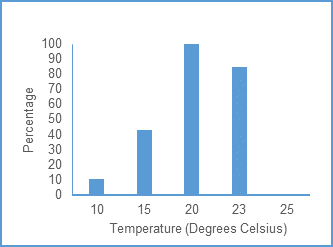
Region - Regionally the influence of climatic conditions can influence periods of greatest risk and need for fungicide intervention. In northern cropping zones epidemics will develop rapidly during milder winter conditions and can diminish suddenly in warmer dry springs while in central and southern regions epidemics may be slower during cooler winters but accelerate and persist in longer milder springs.
Growth stage - Plants are more susceptible to wheat powdery mildew at early growth stages i.e. seedling to stem elongation, where growth rates and carbohydrate levels in crop leaves (food for WPM) are higher and genetic resistance generally lower.

